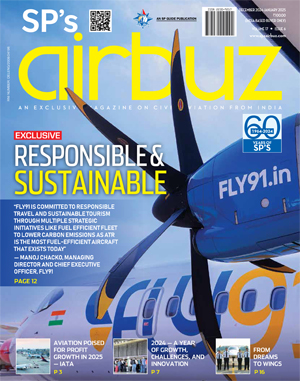A Pipedream or Reality?

Despite impressive growth in civil aviation, regional aviation has not attracted entrepreneurs in proportion to its potential. Only one regional airline, Air Mantra, is operating today albeit anaerobically.
Regional aviation in India has been a nebulous model ever since it was conceptualised and its functionality rendered theoretically possible. The government’s dual track policies, the ‘stick’ of route dispersal guidelines and the ‘carrot’ of concessional aeronautical charges have not had the desired effect of substantially increasing the frequency of flights to Tier-II and Tier-III airports across the country. Indeed, the travesty lies in the figures. Despite impressive growth in civil aviation, regional aviation has not attracted entrepreneurs in proportion to its potential. Only one regional airline, Air Mantra, is operating today albeit anaerobically. Air Mantra is using just two Beechcraft 1900 D with a capacity of 17 seats each. Compare this with the two most popular single-aisle aircraft in Indian skies, the Airbus 320 and the Boeing 737, having about 180 seats. The real import of the picture is stark as even those 17 seats are not being filled up. Is there a strategic vision in the Civil Aviation Ministry for regional aviation? Or is regional aviation doomed to hobble on into the future with Tier-II and Tier-III connectivity remaining a pipedream?
Airport Infrastructure
A simple, self-evident iteration is necessary to focus on airport infrastructure which is capitalintensive and requires high lead time. Both these factors imply that a great deal of perspective planning is required to meet the infrastructural demands of projected air traffic volumes. The growth pattern in aircraft numbers since 2003 has not been matched by corresponding enhancement in airport capacity. Undoubtedly, there has been progress on this front but it has largely been confined to the large airports with public-private participation (PPP) models leading the way. The improvement of Delhi and Mumbai airports and the development of new airports at Bangalore and Hyderabad have been the showcase examples in this context. However, smaller airports have not benefitted to the same extent. Of the 454 airports/airstrips in the country, the Airports Authority of India (AAI) owns and manages 92 airports and 28 civil enclaves at defence airfields. Air traffic services in the entire Indian airspace and adjoining oceanic areas are also provided by AAI. While the total number of airports in actual use by scheduled traffic is 61, more than half of the total traffic is concentrated at Delhi and Mumbai. So is there a need to expand the network and include possibly the entire geographic extent of the country into a bustling air map encompassing each and every airport?
There appears to be no ambiguity about the answer to that question. A majority of foreign tourists visiting India come in through the 17 international airports. However, once a tourist has landed in India, his options for air travel to domestic destinations are somewhat limited as only 61 of the 454 are functional. Domestic demand for travel to all corners of the country is rising sufficiently to indicate the need for many more airports to be made functional. The costs involved would be huge but the debate here is not about bringing up all the airports overnight. Instead, the emphasis is on accepting the need and having a long-term strategy for their development. Plans formulated by the government are invariably subjected to frequent mid-course corrections leading to avoidable delays.
Even those airports that are operational leave a lot to be desired. Some of these have limited watch hours, extension of which involves expenditure and prior notice, usually 24 hours or more. Declared watch hours by themselves do not mean much. At Bhubaneswar, for example, the watch hours start at 0645 hours but the earliest possible take-off possible is around 0730 hours. Handling at most of the small airports is monopolistic/oligopolistic with the designated handlers charging exorbitant rates for their services. While scheduled operators make their own arrangements at stations they regularly operate from, non-scheduled operations pay heavily for their visits to these stations. At Ranchi, an aircraft weighing below 5,700 kg would nominally pay Rs. 15,000 to a handler for just a refuelling halt, even if the crew and passengers stayed with the aircraft for the duration of the halt. Facilities at small airports are a mixed bag and some of them are still not very hospitable to the visiting aircraft and crew. The answer, of course, lies in the government’s vision for airport infrastructure development.
Some of the most popular tourist locales of the country lie in regions least served by air connectivity. The beautiful Northeast, exquisite Himachal Pradesh, charming Uttarakhand and picturesque Jammu and Kashmir have inadequate airports. It is reasonable to presume that when more airports are created in these areas or existing ones operationalised, an increase in the tourist footfalls there could be expected. Mysore did get the required attention and was operationalised. However, it got strangulated due to low passenger traffic. Gujarat has nine airports and an affluent hinterland offering a customer base that can well afford air travel. Yet there has been no regional airline there. In July last year, Captain G.R. Gopinath tried to launch a flight service using his Deccan Charters NSOP as the circumlocutory mode for launching a scheduled service. His efforts were thwarted then by an alert Directorate General of Civil Aviation (DGCA). However, having now been able to overcome the impediments, he has launched Deccan Shuttles, a service connecting nine cities with plans to deploy five single engine Cessna Caravans. Currently, Deccan Shuttles operates daily flights between Ahmedabad and Surat, Ahmedabad and Kandla as also between Surat and Bhavnagar. There are plans to add flights to Jamnagar and Bhuj very soon. However, the number of passengers is restricted to nine as DGCA does not permit a single-engine aircraft to carry more than this number even though the aircraft is certified to carry 12 passengers. As Deccan Shuttles does not operate as a scheduled airline, it cannot publish flight timings or schedule. However, it has circumvented that problem by communicating with customers through its website.





